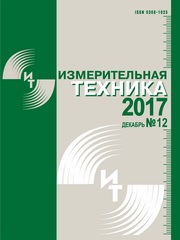- en
- ru
Общество с ограниченной ответственностью
"Научно-производственный комплекс
Электронные и Пучковые Технологии"

Аннотация
Проанализированы требования к методам измерений концентрации водорода в твёрдой пробе. Экспериментально установлены многократные расхождения результатов сличений современных стандартных образцов различных производителей и вероятный источник таких расхождений – метод нагрева и плавления пробы в потоке газа-носителя, применяемый при измерениях. Обоснован вывод о непригодности данного метода для создания системы метрологического обеспечения измерений концентраций водорода в конструкционных материалах, поскольку метрологические характеристики применяемых средств измерений не удовлетворяют требованиям безопасного функционирования объектов современной экономики.
Список литературы
1. Полянский А. М., Полянский В. А., Яковлев Ю. А. Система метрологического обеспечения измерений концентрации водорода в металлах – основа безопасности нефтегазовой отрасли // Измерительная техника. 2013. № 3. С. 56–60.
2. Полянский А. М., Полянский В. А., Пронин А. Н., Горобей В. Н., Чернышенко А. А. Метрологическое обеспечение измерений содержания водорода в материалах для повышения технологической безопасности объектов оборонного комплекса // Вестник Метролога. 2012. № 4. С. 30–36.
3. Belyaev A. K., Polyanskiy V. A., Yakovlev Yu. A. Stresses in pipeline affected by hydrogen. // Acta Mechanica. 2012. V. 224. No. 3-4. P. 176–186.
4. Polyanskiy V., Polyanskiy A., Yakovlev Y. The material interaction with the solute hydrogen during fatigue failure // Lightweight design: 3rd Fatigue Symp. Leoben. 18-19 April 2012, Leoben, Austria. 2012. P. 191–201.
5. Pressouyre G. M. A classification of hydrogen traps in steel // Metallurgical Transactions A. 1979. V. 10 (10). Р. 1571–1573.
6. Tomoki Doshida, Kenichi Takai. Dependence of hydrogen-induced lattice defects and hydrogen embrittlement of cold-drawn pearlitic steels on hydrogen trap state, temperature, strain rate and hydrogen content // Acta Materialia. 2014. V. 79(0). Р. 93–107.
7. Hideki Hagi, Yasunori Hayashi. Effect of Dislocation Trapping on Hydrogen and Deuterium Diffusion in Iron // Transactions of the Japan Institute of Metals. 1987. V. 28(5). Р. 368–374.
8. Kuduzovic A., Poletti M. C., Sommitsch C., Domankova M., Mitsche S., Kienreich R. Investigations into the delayed fracture susceptibility of 34CrNiMo6 steel, and the opportunities for its application in ultra-high-strength bolts and fasteners // Materials Sci. Eng. A. 2014. V. 590(0). Р. 66–73.
9. Il-Jeong Park, Seo Yeon Jo, Minwoo Kang, Sang-Min Lee, Young-Kook Lee. The effect of Ti precipitates on hydrogen embrittlement of Fe–18Mn–0.6C–2Al–xTi twinning-induced plasticity steel // Corrosion Sci. 2014. V. 89(0). Р. 38–45.
10. Polyanskiy A. M., Polyanskiy V. A., Yakovlev Yu. A. Experi-mental determination of parameters of multichannel hydrogen diffusion in solid probe // Intern. J. Hydrogen Energy. 2014. V. 39(30). Р. 17381–17390.
11. Eliezer D., Tal-Gutelmacher E., Cross C., Boellinghaus T. Irre-versible hydrogen trapping in welded beta-21s titanium alloy / Еd. E. Gdoutos. Fracture of nano and engineering materials and structures. Netherlands: Springer, 2006. P. 985–986.
12. Barel E., Hamu G. B., Eliezer D., Wagner L. The effect of heattreatment and {HCF} performance on hydrogen trapping mechanism in timetal {LCB} alloy // J. Alloys Compd. 2009. V. 468(12). Р. 77–86.
13. Nie Y., Kimura Y., Inoue T., Yin F., Akiyama E., Tsuzaki K. Hydrogen embrittlement of a 1500-mpa tensile strength level steel with an ultrafine elongated grain structure // Metall Mater. Trans. A. 2012. V. 43(5). Р. 1670–1687.
14. ГОСТ 23338–91. Сварка металлов. Методы определения со-держания диффузионного водорода в наплавленном металле и металле шва.
15. ГОСТ 21132.1–98. Алюминий и сплавы алюминиевые. Метод определения водорода в твердом металле вакуум-нагревом.
16. Hassel A., Merzlikin S., Mingers A., Georges C., Flock J., Ber-gers K. Methodology of hydrogen measurements in coated steels. Luxem-bourg: Publications Office of the European Union, 2013. [Электрон. версия] http://dx.doi.org/10.2777/10253. http://bookshop.europa.eu/en/methodology-of-hydrogenmeasurements-in-coated-steels-hppm-pbKINA25949/ (дата обращения 03.08.2017).
17. ГОСТ 24956–81. Титан и сплавы титановые. Метод определения водорода.
18. Проценко О. М., Карачевцев Ф. Н., Механик Е. А. Опыт разработки методики измерения содержания водорода в титановых сплавах // Электронный журнал. Труды ВИАМ. 2014. № 12-8-8. doi: 10.18577/2307-6046-2014-0-12-8-8.
19. Защита нефтепромыслового оборудования от коррозии: Справочник рабочего / Под ред. Л. С. Саакнян, А. П. Ефремова, И. А. Соболевой. М.: Недра, 1985.
20. ГОСТ 17745–90. Стали и сплавы. Методы определения газов.
21. Polyanskii A. M., Polyanskii V. A., Yakovlev Yu. A. Investigation of the completeness of specimen degassing in an analysis of the hydrogen content of aluminum alloys // Metallurgist. 2011. V. 55. No. 3-4. P. 303–309.
22. Andronov D. Yu., Arseniev D. G., Polyanskiy A. M., Polyanskiy V. A., Yakovlev Yu. A. Application of multichannel diffusion model to analysis of hydrogen measurements in solid // Intern. J. Hydrogen Energy. 2017. V. 42. No.1. P. 699–710.
New metrological support of measurements of hydrogen concentration in a solid sample.
Аuthors: L. A. Konopelko, A. M. Polyanskiy, V. A. Polyanskiy, Yu. A. Yakovlev.
Keywords: measurement of the hydrogen concentration in the solid sample.
Pages: 46-50
DOI: 10.32446/0368-1025it.2017-12-46-50
Annotation
The article analyses the requirements of modern industrial technology to the measurement of the hydrogen concentration in the solid sample. The results of the described experiments show that there are multiple discrepancies in the comparisons of standards from different manufacturers on the market today. One of the most likely sources for this discrepancy is the method of heating and melting the sample in a stream of carrier gas. The conclusion about his unsuitability for the creation of the Metrology system, and to measure the concentrations of hydrogen in structural materials on the level of values and precision required for the safe functioning of modern economies.